Posted by Chuck Wagner on 07-16-2005 03:23 PM:
Wall Hangings and Decorative Panels
Hi all,
I'll start this thread with a suzani (this should get Richard
going) from Nurata, in Uzbekistan. It's not an old one, about 30 years old, but
it's quite attractive and well done. Colors are subtle and the design is
relatively uncluttered (no, really, I'm serious. You should see the
busy ones). It was drawn on the cloth with a pen, and then embroidered.
Traditionally, suzanis are used on walls in an urban environment, and as
hanging dividers in rustic or temporary (read: yurts) dwellings. More
contemporary uses are as bedspreads, table covers, etc. This piecce was done by
a woman named Nargiza:
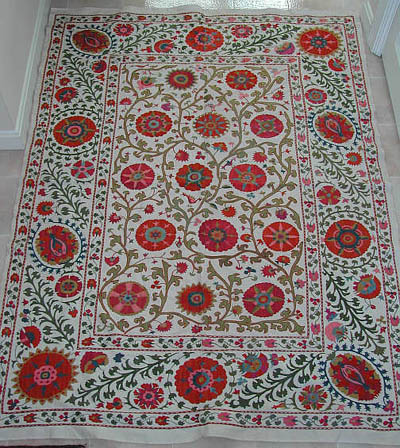


Regards,
Chuck Wagner
__________________
Chuck
Wagner
Posted by Richard Farber on 07-18-2005 01:08 AM:
dear mr wagner,
i surely agree that the embroidery is beautiful . . .
.
and i believe that you might have some interesting information for
us.
you wrote that you know the name of the embroideress [or perhpas she
is the person with the kalam who drew the design ?? this might be possilbe too]
do you know from an informant that this piece was done in around 1975? [thirty
years ago]
if so i was under a false impression . . . becuase the new
embroideries that i would see 25 years ago were garrish and synthetic and did
not really attempt to go back to the 19th century roots -- this is why i would
think that your embroidery is contemporary or nearly so --
this question
is when did the people there attempt to recreate an earlier style -- i had
thought that it was later -- perhaps just in the
1990's
sincerely
richard farber
your piece should
age very well and really take on a good patina in a generation or three.
Posted by Filiberto Boncompagni on 07-18-2005 03:56 AM:
Hi Richard,
What abound the ground cloth as a clue to the age of these
suzanis?
I read that old ones were embroidered on cotton or linen and the
more recent are made on silk.
My two suzanis, of recent production, are on
silk. Actually, the cloth has white cotton warps and beige-gold (very fine)
wefts.
Do we know when they started using this type of
fabric?
Regards,
Filiberto
Posted by Chuck Wagner on 07-18-2005 09:06 AM:
Hi Richard,
I had to go back and find the email containing the
information on this suzani. For starters, you can subtract 5 years from the age;
my recollection was incorrect. Here's the quote from the
seller:
---------------------------------------------------------------------------
The
name of the city of suzani is Nurata. This suzani has been made by women named
Nargiza. The age about 23-24 years
old.
--------------------------------------------------------------------------------
I
have had more extensive communications with the seller regarding other items,
and Uzbek textiles in general. He has made several offerings that were
represented up front as brand new production, so I am inclined to accept his
statement that this is a 1980-ish piece.
I will ask him if he has any
comments regarding your observations and post the response if he has anything to
add.
Note that he uses women, not woman; because he's not a native English
speaker, I don't know if that means a family, or a woman, named Nargiza. I'll
ask about that as well.
For Filiberto, the ground cloth for this piece is
two vertical strips of lightweight commercial cotton cloth, machine-stitched
together.
I'm hoping that Richard has a few images for us; the Textile
Quiz Salon has betrayed his collecting habits and I'm sure he's got other pieces
he can show us (as do some others, I suspect). 
Regards,
Chuck
__________________
Chuck
Wagner
Posted by Filiberto Boncompagni on 07-18-2005 09:16 AM:
OOOOPS! Just realized that I forgot a word...
Read my last post
as:
Actually, the cloth has white cotton warps and beige-gold (very
fine) SILK wefts.
Chuck,
Perhaps "The age about
23-24 years old." is the gir's age 
Filiberto
Posted by Amir_Aharon on 07-18-2005 10:43 AM:
Hi Chuck, Richard, All
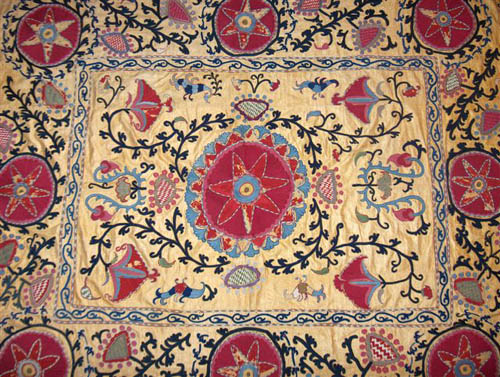
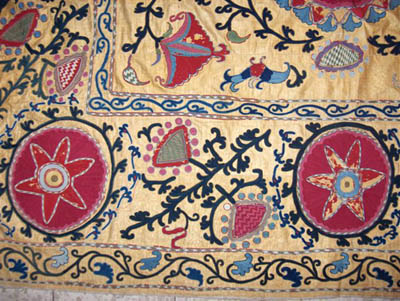
I think Chuck's
suspicion is in order. I was planning to post this silk ground (Lakai?) suzani
after the disappearance of the 2-sided asmalyk from the screen; but I can't wait
anymore. I had to take the Chuck challenge.
First, I too have something
to say about the mysterious Nargiza. I suppose this is a variant of the Persian
name Nargess which is the showy flower of the Narcissus plant. If she is 23-24
(Filiberto's guess) years old then maybe Chuck can arrange to post her image.
Forget the suzani, she's still in her adolescence.
I will gladly post
more images and information if there is any interest or query.
Amir
Posted by Richard_Farber on 07-18-2005 12:20 PM:
Dear All
The ground cloth and the backing cloth can give indications
of the age of a piece. I wrote about a little velvet with two niches just awhile
ago and talked about this.
There were 19th century suzanis on silk and on
karbos . .which is hand woven cotton cloth, and there is an occasional suzani on
machine made cloth which still might well be 19th century.
Here are
images of relatively early nim susanis (the half sized ones) on single color
ikat.




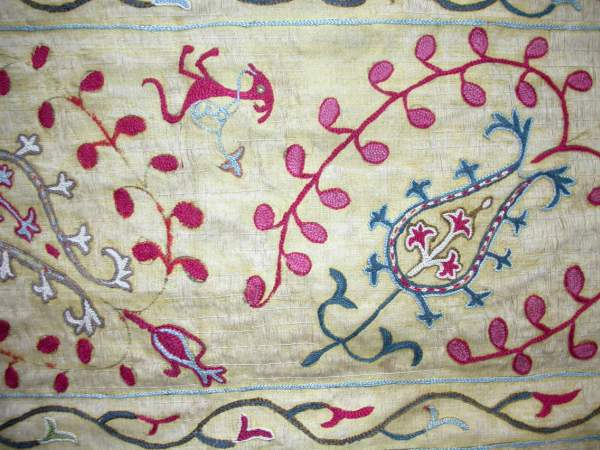
Sincerely
Richard
Farber
Posted by Filiberto Boncompagni on 07-18-2005 12:35 PM:
Hi Amir,
Yes, I’d like to know if the silk ground of your Suzani (very
nice, by the way) is totally silk or has cotton warps and silk wefts like mine…
Which I post again, for those who didn’t see them a few months ago.


The second one - of the size
of an handkerchief - has a particularity: only the dark red is silk, the rest of
the colors are in wool.
Regards,
Filiberto
Posted by Amir_Aharon on 07-19-2005 02:37 AM:
Hi Filiberto,
From first glance your big suzani image looks modernish;
but then you can see and touch it, so you should know better. The handkerchief
though is very attractive. How old is it? The different red hues and the gold
are so compatible. The motifs are nice too. I haven't seen any suzani with the
two moonlike central patterns flanking the central roundel before.
You
mentioned in your last post that only the dark red is silk; you are
lucky the
handkerchief is in such good condition despite the wool threads. You may have
noticed one of the reds (there are 3 juxtaposed hues) in my yellow suzani above.
It looks as if it was partly worn out. This red is actually the only color
embroidered with a woollen thread. All the rest are silk. This scarlet red
thread was in fact edible. The restorer who worked hard to re-embroider this red
(she is still working at it) found and showed me the culprit (one of them) who
did all the damage. A very tiny overfed purple worm. I had to fumigate just
in
case there were others.
I just hope the woman was working faster than
the worm. As for your
Question about the yellow ground warp and weft:
The
weft is 100% silk and I asked her to do the burning test on the warp.
The
thread was consumed right away on burning which probably makes it also silk. But
I have to do it myself when I next visit her.
The big red roundel is
after reweaving the damaged (devoured) scarlet.

The back of the suzani is quite
interesting because of the fact that they added this printed cotton plus another
ivory delicate cotton (karbaas!?) to support the yellow silk ground, and then
did the embroidery. The stitch is mostly tambour stitch. The suzani is
probably
mid to early 19th century from the Shahresabz area .

Regards
Amir
Posted by Filiberto Boncompagni on 07-19-2005 03:27 AM:
Hi Amir,
No old aristocrats, here.  Like Chuck’s, mine are modern.
Like Chuck’s, mine are modern.
Both
on a very similar cloth that looks machine-made.
The smaller one seems
oldish, though. Twenty or thirty years, maybe. That’s why I am interested in
knowing since when they started using that kind of ground cloth.
Thanks
for the hint on the wool-eating worms. I’ll store my suzanis with some
camphor...
Hope it helps to keep the worms
away.
Regards,
Filiberto
Posted by Richard Farber on 07-19-2005 04:50 AM:
ciao filiberto,
in the case of uzbeck embroidery in the last years the
quality has greatly improved since the end of the soviet era. greatly
emproved . there was a return to natural colors and old techniques so in
your case i would think that these embroideries were made after the end of the
old soviet period.
neighborly regards
r
Posted by Filiberto Boncompagni on 07-19-2005 05:42 AM:
Hi Richard,
Thanks. I see. So, in the case of modern suzanis, the
younger the better, huh? 
Regards,
Filiberto
Posted by Richard Farber on 07-19-2005 06:04 AM:
filiberto yes, in this case early 21st is much better than mid 20th
mr
amir aharon, is there any wool thread in your piece, any crimson or red wool in
particular ?
sincerely
richard farber
Posted by Amir Aharon on 07-19-2005 01:06 PM:
Crimson wool
Hi Richard,
I believe that I did mention one red thread of wool in my
last post to Filiberto.
I wonder why they had to use wool when all the
rest of the
colors including two other red hues are silk. I do know that
this specific red dye was imported to central Asia from India
at the
time. Was it because wool absorbs this dye better than
silk? I honestly have
no idea.
Regards,
Amir
Posted by Richard Farber on 07-19-2005 01:30 PM:
dear all and mr aharon amir in particular,
the use of red woll in
uzbeck susanie in according to Suchareva 1937 : 12
an indication of age .
. . it was imported from india to central asia not early than the middle of the
19th cent. and disappered in the 1880's --
i would suggest than the
dating of your piece than to the third quarter [or fourth] of the 19th cent. . .
why was it imported .. .it had a strong crimson like color. it was used
vry often in the central area of the flowers.
is no one out there going
to guess an age on the two nim susanis that i put on the site
????
regards
richard
n.b. there was a french
colleague who would have been very happy to see the design of the botehs on the
yellow ikat ground piece . . . perhaps someone who has access to his address
would give him a "heads" up.
Posted by Chuck Wagner on 07-20-2005 09:26 AM:
Electronic CorrectTape
Hi all,
Well, Filiberto is right. Nargiza (it's a first name, not a
family name) is in her twenties, not the suzani. I asked the seller to provide
some clarification about the Nargiza question, and what he knows of age
determination of suzanis. Here is his response, as received (his English is
way better than my
Uzbek):
-------------------------------------------------------------------------------
When
I have told you about Nurata Suzani I mean that the woman who made it named
Nargiza, and her age is 23-24 years old. It' wasn't a family, just a one woman
who makes an embroidery.
About dyes you are right the vegetable dyes
began to use about 1990s, so now the colors of embroidery are very nice. The
pure Silk foundation are usually specify that the age of the item is an early of
20th century, and the reagions Tashkent and Ferghana,
somtimes
Samarkand.
The home spun cotton foundation is usual for 18-19 centuries-
it's really Old even Antique, and it has very many reagions, because it was all
over the Uzbekistan. The ordinary cotton foundation , especially suzani with red
color foundation are 1950 -60s. They used the Fabric of Tashkent textile
comninate , which has been open in 1932 year.
Hope this inforamation will
be useful for
you.
-------------------------------------------------------------------------------
It's
good that his opinion regarding the recent vegetable dyed suzanis is consistent
with that of everyone else. Obviously, I was confused by his initial response,
but that's been fixed.
Also, for your viewing pleasure and following up
on his remark about silk foundations, here's a pretty zardevor, from the
Ferghana region, to look at. Zardevors are hung along the top of a wall in an
urban environment and along the upper edge of a yurt wall. It's about 150 inches
long and 32 inches high. Foundation is a very fine, very thin yellow silk, and
is constructed from two long strips of silk (the upper quarter is a separate
piece). The seller represents it as turn of late 19th - early 20th century.


Regards,
Chuck Wagner
__________________
Chuck
Wagner
Posted by Richard Farber on 07-20-2005 10:01 AM:
dear turkotekees,
beware of silk textiles in perfect condition
that are said to be 19th cent.
silk does not age all that well. have a look
at the backing of the two nim suzanis that i posted
may i suggest that
the colors of the long suzani that mr wagner put on the site are probobly not
natural colors . . . i know this type of color as "chrome"
i would guess that
the piece in not older then the 1930's and could be a lot younger than that. . .
.
might i suggest that steve or filibeto put up some of the images of
mystery item number six from the attribution game that we played a few months
ago . . and put the image of the "sardevor" susani next to it so that you can
get an idea of the difference in the colors . . . .
about the suzani
of mr aharon amir . . . . the dyed red wool was imported from india and not just
the dye itself.
sincerely
richard farber
Posted by Steve Price on 07-20-2005 10:18 AM:
Hi Richard
Here's the one from your Salon,

And, for comparison,
Chuck's Sardevor,

Regards
Steve Price
Posted by Richard Farber on 07-20-2005 10:49 AM:
dear all
one can well see the same tradition in the design of the
flower sprays and of the concept of the colors -- banded colors on the leaves
single colors on the flower heads [or pomagranates] .. for my eye no problem
in saying that two pieces are from the same tradition. . . the question then is
what is the difference and that can be seen in the colors themselves . . . i
asked steve price to put up a couple of closeups that were on the attribution
game site
regards
r
Posted by Steve Price on 07-20-2005 11:15 AM:
Hi Richard
Here are three closeups from your Salon:



Regards
Steve
Price
Posted by Chuck Wagner on 07-20-2005 01:29 PM:
Hi Richard,
When someone tells me late 19th - early 20th century, I'm
thinking anywhere from 1875 to 1925. Based solely on the dyes in the yarn, I
figured that this is a 1920's piece. Another person, who has worked with old
textiles in the conservation business here in the US, has looked at both of my
silk foundation pieces (other pics coming later) said 1920's for both, based
mainly on the presence of some rayon in the embroidery and the condition of the
silk.
This piece is hardly in perfect condition. It is big, and the
previous images don't really show the details very well. It has numerous stains,
it suffers from some sunlight-related embrittlement, and looks to have provided
many small but healthy meals to moths over time. Regardez:
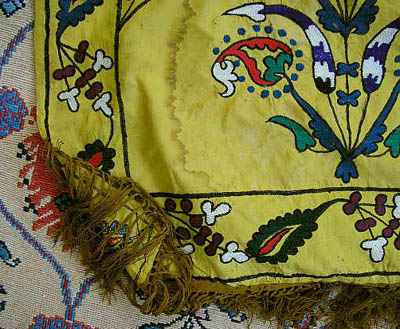

Regards,
Chuck
__________________
Chuck
Wagner
Posted by Richard Farber on 07-20-2005 02:14 PM:
dear chuck wagner,
might i suggest that you do some closeup of similar
floral sprays .. so that the can be put side by side with the sprays form the
earlier piece . . then design color and detail of the execution can be more
easily compared
i think that this will help those of you who ask about
how you "know" the age of a piece
i would have thought 1930 according to
the pallet so we are surely in agreement . . i like you piece very
much
sincerely
richard farber
and thanks to
steve for posting the images
Posted by Amir_Aharon on 07-20-2005 02:34 PM:
Hi All,
Here is a yellow silk ground suzani from the Marshall and
Marilyn Wolf Collection---Keshte plate # 33

It has very similar motifs
to the suzani I posted . The color palettes are almost identical. In the
technical analysis appendix they write that the stitches are chain stitch
variants, so is mine. The size is 215.9X175.3 cms., mine is 235X175 cms. The
caption mentions 6 silk panels backed with printed cotton and edged with
ikat.
It also says the embroidery is in WOOL. I wonder if they are
speaking of the crimson red hue in the numerous tiny triangles of the central
roundel and the main border star motifs, or ALL the rest of the colors. This is
not clear from the appendix technical caption.
Maybe someone who's
reading this post and personally knows the Marshalls can please ask them about
the threads; whether they are all wool or just the crimson (the red wool from
India which was mentioned by Mr. Farber).
I also wonder if they have
encountered any wool-eating worms, or is this asking too much?!
'Redily'
and 'Woolingly' Yours,
Amir
Posted by Chuck Wagner on 07-20-2005 05:25 PM:
Florals
Hi Richard,
OK, here are closeups of the design elements. This will be
a little tedious because I can't but them beside each other. Also, I'll note
that the pattern appears to have been drawn with a quill pen of some sort,
rather than pencil, marker, or ball point pen:

Now, the floral elements, in
order from left to right:









And finally, the wreath form above the florals, and a shot of
the back:


Regards,
Chuck
__________________
Chuck
Wagner
Posted by Steve Price on 07-20-2005 06:56 PM:
Hi People
Here are some more illustrations of recent Uzbek suzani
work. The first three were gifts from a dear friend who is also a dealer in
antique textiles. They are each about 15" square, and were probably made during
the past 5 years.


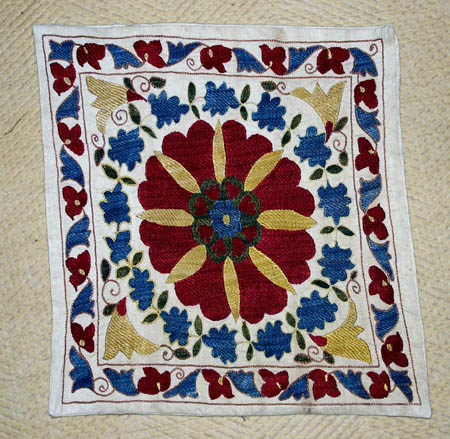
This one was given to
us by someone who knows little about antique textiles, but does know that we
collect them. It's larger than the others, and my guess is that it was made
between 1960 and 1980.

The color reproduction is off, of course, but I think it's
good enough to make it possible to see how nice the new work
is.
Regards
Steve Price
Posted by Richard Farber on 07-21-2005 12:30 AM:
dear mr amir aharon
in one of the close ups of the susani at the
bottom of page one in this thread one can see a bit of the red indian wool left
at the flower at the top of the
spray
regards
richard
i am still waiting for
the brave and silent to compare the two nim suzanis that i posted on this thread
and venture an opinion as to relative age
Posted by Chuck Wagner on 07-22-2005 08:42 AM:
Hi Richard,
Ignorance can instill a sense of bravery in an otherwise
very cautious person, so, here's a guess at relative age for your two
suzanis.
I think the one with the loosely woven white ground is older. I
base this almost entirely on how the colors appear on my monitor; there is what
appears to be a very bright green in the detail of the piece on purple silk that
doesn't look like a vegetable dye to me.
Execution of the designs appears
to be at roughly the same level of sophistication, so the design elements don't
provide many hints. I can't really comment on the condition of the silk without
handling it, but the backing looks like woodblock print, which would also be a
late 1800's/very early 1900's feature (I think...).
Anyway, that's my
guess.
Regards,
Chuck
__________________
Chuck
Wagner
Posted by Chuck Wagner on 08-03-2005 04:09 PM:
Silk on silk
Hi all,
Here's the purple suzani I mentioned earlier. This one is
from the Ferghana valley, and shows two features quite typical of textiles from
this region of far eastern Uzbekistan. The design is simple and uncluttered.
Also, the design contains symbols relating to an earlier time of mystical
beliefs with a much closer connection to western China than have other suzani
designs. Similar motifs are found on Kyrgyz textiles, not surprising given that
Kyrgyzistan sorrounds much of the region.
The images are deceptive with
regard to condition; the silk ground is quite fragile and will soon have a
proper backing for support. There are numerous stains and repaired tears, and
spots of fading due to exposure to sunlight. A person knowledgable on this topic
places it in the 1910's-1930's, as was the yellow zardevor.
Here are the
images:



Regards,
Chuck Wagner
__________________
Chuck
Wagner
















 Like Chuck’s, mine are modern.
Like Chuck’s, mine are modern. 



























